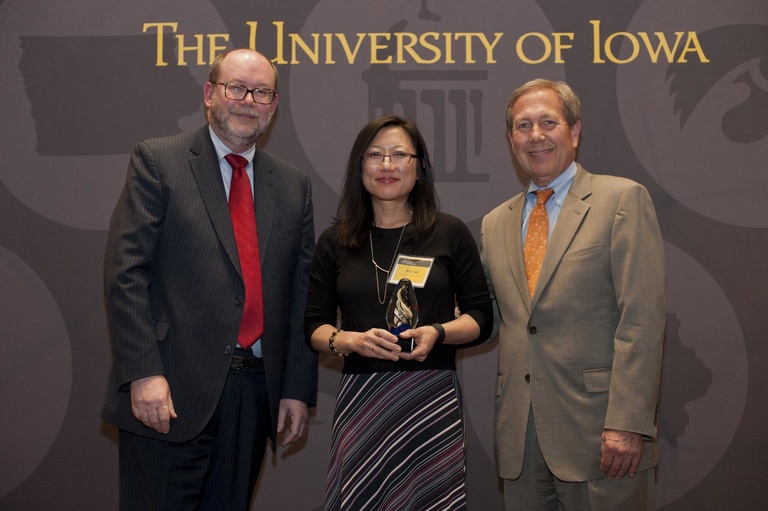
Communicating complex scientific research to a lay audience is an important skill for researchers—but it doesn’t always come naturally.
Amy Lee, Professor of Molecular Physiology & Biophysics and Assistant Dean for Research in the Carver College of Medicine, helped organize and took part in a workshop in December of 2014 to help faculty members in the College of Medicine learn to communicate their science to a wide variety of audiences.
“It’s not easy,” Lee said. “You really have to practice talking in a way that you’re not used to when you’re talking in front of specialists.”
The faculty received training from a television news reporter, and a select group was invited to participate in videos produced by the UIHC Marketing and Communications Department. Lee wrote a script for the video about her lab, which she submitted a year later to a contest sponsored by the Association for American Medical Colleges (AAMC). The video won third place, and in April, Lee was recognized by the Office of Research and Economic Development with the new Faculty Communicating Ideas Award.
Lee said the workshop and video helped her realize the impact of being able to communicate her research to many types of people. Patients might see it and decide the University of Iowa would be a great place for them to seek treatment for their hearing loss, or potential donors might see it and be motivated to support hearing research.
“There are a lot of applications for a product like that,” Lee said. “I just learned about the power of that type of media in communicating science.”
One focus of Lee’s research is exploring how alterations in a specific calcium channel required for the transmission of sound information impacts the function of hair cells in the ear. Her lab wanted to learn why these channels behave differently in certain physiological contexts compared to in an artificial system. The hypothesis is that there are things present in the brain and in the heart that change the properties of the channels to suit their function in that particular cell type. Hair cells in the ear only have one type of calcium channel, compared to the four or five present in most neurons in the brain, so they became an ideal system for Lee’s research.
“We got into the biology of the ear, and it was a fascinating process to learn about because hearing encapsulates everything you want to know about how the brain works,” Lee said. “You get a sensory stimulus, which is sound. The cells have to be able to sense that and then communicate it and ultimately process it in the brain.”
At the same time, the ear is a simple system compared to parts of the brain involving learning and memory. In the hearing process, you know what the input is, and you know what the output is.
“It’s a very easy system to study a very complicated neuroscience problem,” Lee said.
Her lab has successfully identified the mechanism in the ear that regulates the calcium channel and transforms its properties. The team has since found that a human mutation that causes a hereditary form of hearing loss possibly by preventing the regulation of the channel.
“That was very gratifying to see that a mechanism we’d been studying for so many years actually is important in regulating these channels’ ability to regulate sound,” Lee said.
By understanding the molecular mechanisms involved in the communication of sound, Lee says she and her team will gain better insight into what happens when things go wrong. Someday, the work could lead to new therapeutics to treat hearing loss.
And because of her work cultivating, and promoting, better communication of science, the public is likely to have a better understanding of why this work matters.